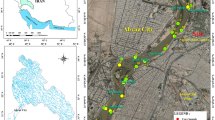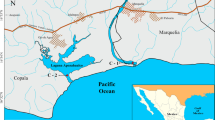Abstract
Traditional chemical methods have mainly focused on the variation and transportation of elements in the aquifer layer. The primary goal of this paper was to establish a spatial distribution model of chemical elements in the critical zone (CZ). The effects of anthropogenic activities (AA) and CZ structure on these models are quantitatively described. To this aim, 200 sediment and pore water samples were collected from ten drills in two profiles and analyzed for 16 variables. The most important influencing factors were identified from CZ structure parameters, and the effects of AA and CZ structure on chemical variables in the CZ were quantitatively characterized. Distribution models of the influences of AA and CZ structure were established for these two profiles. The correlation coefficient of the clay fraction content was greater than the other parameters, which was negative with total dissolved solids (TDS) and the arsenic of pore water and was positive with the arsenic in sediments. The distribution model of chemical variables was divided into three components: CZ1, CZ2, and A-A, which represent the effects of the first and second most important influencing factors and AA. The distribution models of chemical variables and their A-A part had the strongest similarity. The clay fraction content was more important than the other CZ structure parameters. It can inhibit the TDS and arsenic of pore water migration, resulting in greater arsenic ion adsorption on the sediment. AA is a triggering factor for chemical variables transportation, and CZ structure has an amplification effect on AA. According to characterize the spatial distribution of chemical variables in sediment and pore water within the CZ, the effects of AA and CZ structure can be quantitatively described, providing a rapid and effective technique for ecological environmental protection.








Similar content being viewed by others
References
Baker JA, Elphick JR, McPherson CA, Chapman PM (2015) Effect of total dissolved solids on fertilization and development of two salmonid species. Bull Environ Contam Toxicol 95(4):488–493
Berdanier BW, Ziadat AH (2006) Evaluation of a total dissolved solids model in comparison to actual field data measurements in the Cheyenne River, South Dakota, USA. Environ Monit Assess 117(1):335–344
Chen L, Zhou CH, Fiore S, Tong DS, Zhang H, Li CS, Ji SF, Yu WH (2016) Functional magnetic nanoparticle/clay mineral nanocomposites: preparation, magnetism and versatile applications. Appl Clay Sci 127:143–163
Gal H, Weisbrod N, Dahan O, Ronen Z, Nativ R (2009) Perchlorate accumulation and migration in the deep vadose zone in a semiarid region. J Hydrol 378(1):142–149
GB 5749-2006 (2006) Standards for drinking water quality. Ministry of Health of the People’s Republic of China
Goldhaber MB, Mills CT, Morrison JM, Stricker CA, Mushet DM, LaBaugh JW (2014) Hydrogeochemistry of prairie pothole region wetlands: role of long term critical zone processes. Chem Geol 387:170–183
Hamzah A, Wong KK, Hasan FN, Mustafa S, Khoo KS, Sarmani SB (2013) Determination of total arsenic in soil and arsenic-resistant bacteria from selected ground water in Kandal Province, Cambodia. J Radioanal Nucl Chem 297(2):291–296
Hissler C, Stille P, Guignard C, Iffly JF, Pfister L (2014) Rare earth elements as hydrological tracers of anthropogenic and critical zone contributions: a case study at the Alzette river basin scale. Procedia Earth Planet Sci 10:349–352
Hybel AM, Godskesen B, Rygaard M (2015) Selection of spatial scale for assessing impacts of groundwater-based water supply on freshwater resources. J Environ Manag 160:90–97
Kent R, Landon MK (2013) Trends in concentrations of nitrate and total dissolved solids in public supply wells of the Bunker Hill, Lytle, Rialto, and Colton groundwater subbasins, San Bernardino County, California: influence of legacy land use. Sci Total Environ 452:125–136
Kim HK, Jang TI, Kim SM, Park SW (2015) Impact of domestic wastewater irrigation on heavy metal contamination in soil and vegetables. Environ Earth Sci 73(5):2377–2383
Kobya M, Demirbas E, Ulu F (2016) Evaluation of operating parameters with respect to charge loading on the removal efficiency of arsenic from potable water by electrocoagulation. J Environ Chem Eng 4(2):1484–1494
Lara MC, Buss HL, Pogge von Strandmann PAE, Dessert C, Gaillardet J (2014) Controls on the Mg cycle in the tropics: insights from a case study at the Luquillo critical zone observatory. Procedia Earth Planet Sci 10:200–203
Larba R, Soltani N (2014) Use of the land snail helix aspersa for monitoring heavy metal soil contamination in northeast Algeria. Environ Monit Assess 186(8):4987–4995
Li X, Shao M, Jia X, Wei X (2016) Profile distribution of soil-water content and its temporal stability along a 1340 m long transect on the Loess Plateau, China. Catena 137:77–86
Lin H (2010) Earth's critical zone and hydropedology: concepts, characteristics, and advances. Hydrol Earth Syst Sci 14(1):25–45
Liu J, Li Y, Zhang B, Cao J, Cao Z, Domagalski J (2009) Ecological risk of heavy metals in sediments of the Luan River source water. Ecotoxicol 18(6):748–758
Liu D, Ma J, Sun Y, Li Y (2016) Spatial distribution of soil magnetic susceptibility and correlation with heavy metal pollution in Kaifeng City, China. Catena 139:53–60
Mattern S, Vanclooster M (2010) Estimating travel time of recharge water through a deep vadose zone using a transfer function model. Environ Fluid Mech 10(1):121–135
Mora JL, Guerra JA, Armas-Herrera CM, Arbelo CD, Rodríguez-Rodríguez A (2014) Storage and depth distribution of organic carbon in volcanic soils as affected by environmental and pedological factors. Catena 123:163–175
Qiao S, Shi X, Fang X, Liu S, Kornkanitnan N, Gao J, Zhu A, Hu L, Yu Y (2015) Heavy metal and clay mineral analyses in the sediments of upper gulf of Thailand and their implications on sedimentary provenance and dispersion pattern. J Asian Earth Sci 114(3):488–496
Raj D, Shaji E (2017) Fluoride contamination in groundwater resources of Alleppey, southern India. Geosci Front 8(1):117–124
Schotanus D, Meeussen JC, Lissner H, Ploeg M, Wehrer M, Totsche K, Zee S (2014) Transport and degradation of propylene glycol in the vadose zone: model development and sensitivity analysis. Environ Sci Pollut Res Int 21(15):9054–9066
Shamsudduha M, Taylor RG, Chandler RE (2015) A generalized regression model of arsenic variations in the shallow groundwater of Bangladesh. Water Resour Res 51(1):685–703
Shrestha S, Semkuyu DJ, Pandey VP (2016) Assessment of groundwater vulnerability and risk to pollution in Kathmandu Valley, Nepal. Sci Total Environ 556:23–35
Todorovic GR, Lair GJ, Blum WEH (2014) Modeling and prediction of C dynamics in soil chronosequences of the critical zone observatory (CZO) Marchfeld/Austria. Catena 121:53–67
Usman A, Kuzyakov Y, Stahr K (2005) Effect of clay minerals on immobilization of heavy metals and microbial activity in a sewage sludge-contaminated soil. J Soils Sediments 5(4):245–252
Virdi ML, Lee TM, Swancar A, Niswonger RG (2013) Simulating the effect of climate extremes on groundwater flow through a lakebed. Groundwater 51(2):203–218
Von-Blanckenburg F, Schuessler JA (2014) Element cycling in the critical zone as viewed by new isotope tools. Procedia Earth Planet Sci 10:173–178
Wang X (2008) Correlations between heavy metals and organic carbon extracted by dry oxidation procedure in urban roadside soils. Environ Geol 54(2):269–273
Wang H, Li X, Xie Y (2011) Hydrochemical evaluation of surface water quality and pollution source apportionment in the Luan River basin, China. Water Sci Technol 64(10):2119–2125
Wang Z, Sun R, Zhang H, Chen L (2015) Analysis and assessment of heavy metal contamination in surface water and sediments: a case study from Luan River, northern China. Front Environ Sci Eng China 9(2):240–249
Zeng X, Wu J, Wang D, Zhu X (2016) Assessing the pollution risk of a groundwater source field at western Laizhou Bay under seawater intrusion. Environ Res 148:586–594
Zhang Y, Ma R, Li Z (2014) Human health risk assessment of groundwater in Hetao Plain (Inner Mongolia Autonomous Region, China). Environ Monit Assess 186:4669–4684
Zhong X, Kealy A, Duckham M (2016) Stream Kriging: incremental and recursive ordinary Kriging over spatiotemporal data streams. Comput Geosci 90:134–143
Funding
This work was supported by the National Natural Science Foundation of China (41502248) and Geological Survey Projects Foundation of Institute of Hydrogeology and Environmental Geology (G201605 and SK201504).
Author information
Authors and Affiliations
Corresponding author
Rights and permissions
About this article
Cite this article
Ma, R., Zhou, X. & Shi, J. Spatial variation of chemical variables in the critical zone of the Luan River catchment in north China plain. Arab J Geosci 11, 516 (2018). https://doi.org/10.1007/s12517-018-3827-5
Received:
Accepted:
Published:
DOI: https://doi.org/10.1007/s12517-018-3827-5




